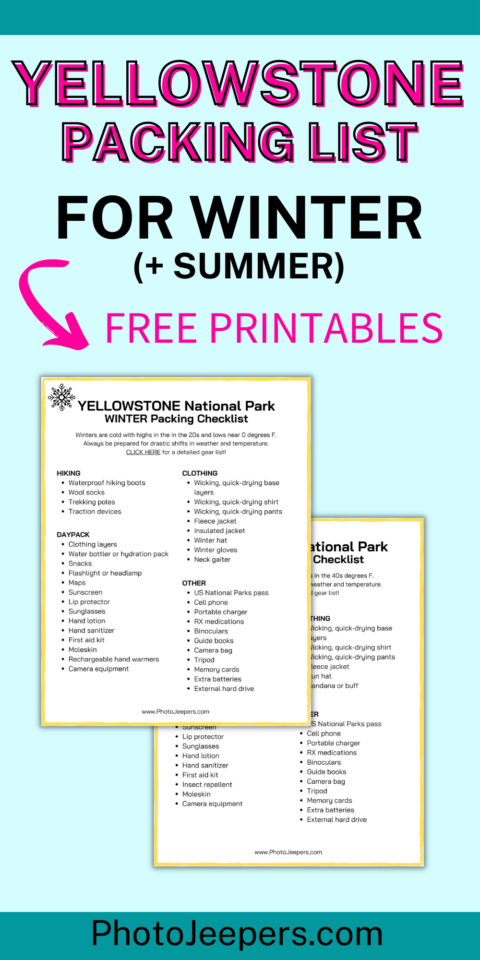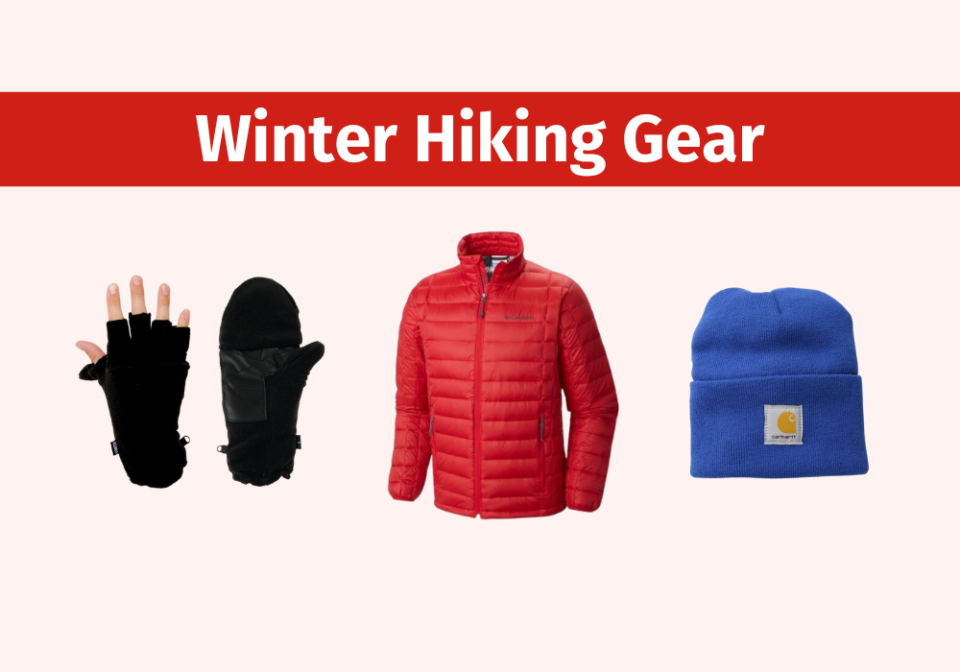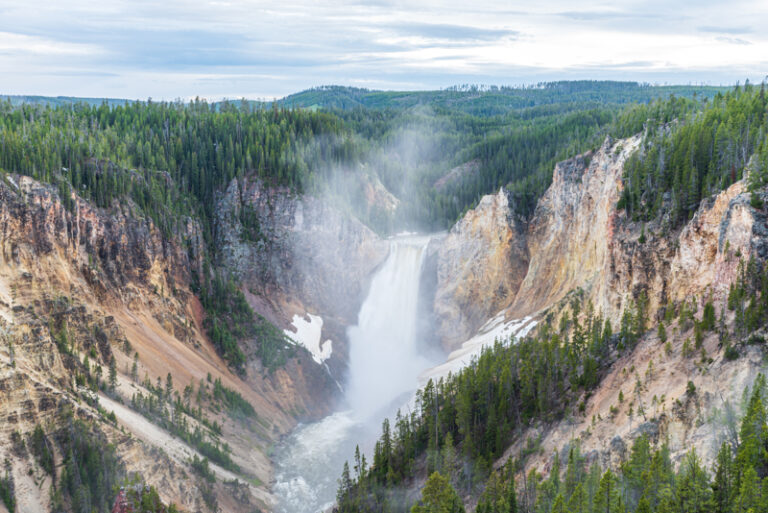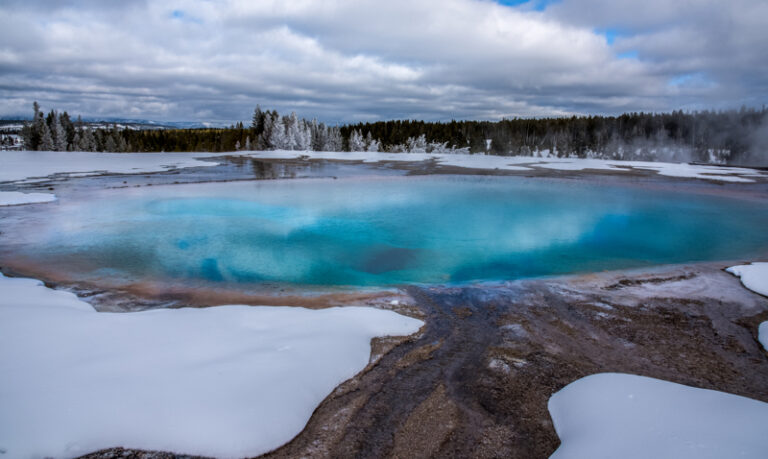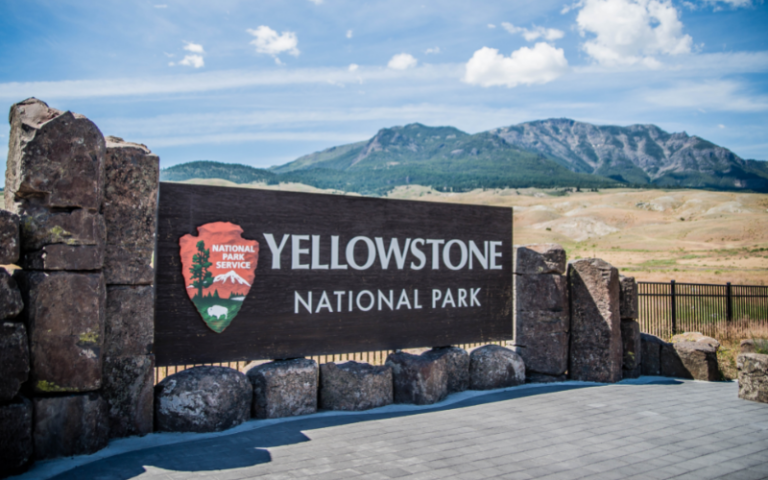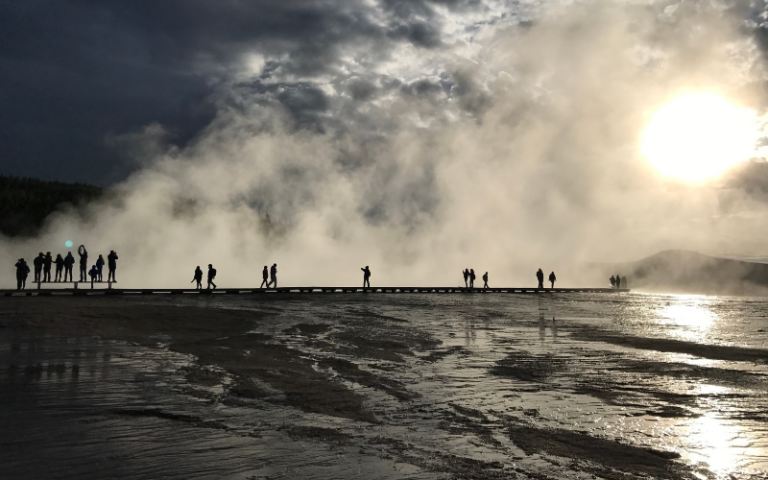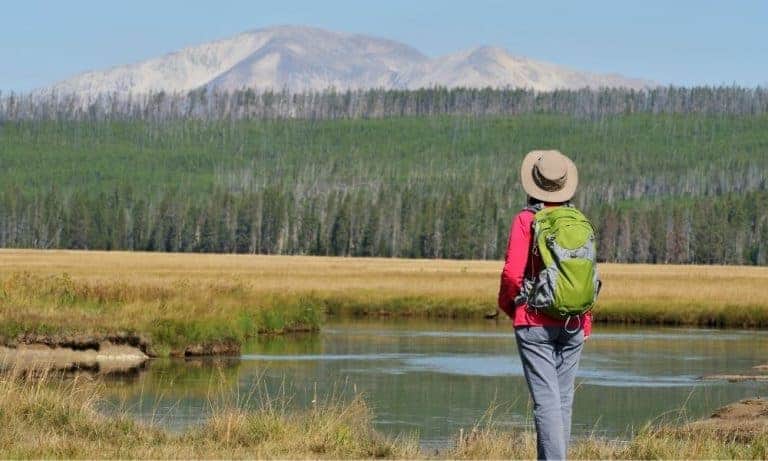Packing for a Winter Vacation in Yellowstone National Park
Visiting Yellowstone in the winter is a magical experience, but it’s crucial to be prepared for the unique challenges that the season brings. Packing for a winter vacation in Yellowstone National Park requires some careful planning.
The winter Yellowstone packing list we’ve put together below is fairly comprehensive, and you may not need every item depending the activities you will do so make modifications to the list as needed.
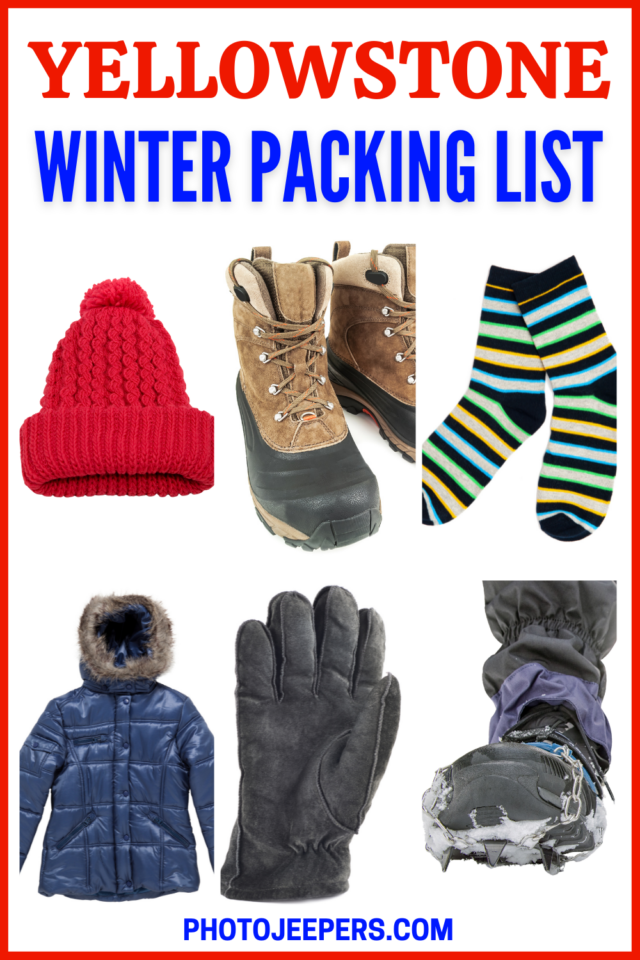
Having the right winter clothing and gear for a vacation in Yellowstone is crucial for a couple of reasons. First and foremost, it ensures your safety. Winter in Yellowstone can dish up some severe conditions, with temperatures often dropping well below freezing.
Being appropriately dressed allows you to comfortably and fully explore all that Yellowstone has to offer in the winter. Whether it’s trekking through snow-laden trails, watching geysers erupt amidst a snowy backdrop, or spotting wildlife in their winter habitats, the right gear will keep you warm and dry, letting you focus on the beauty around you rather than battling the cold.
Download the winter (and summer) packing lists for free below!
This site contains affiliate links which means WE may receive commissions for purchases made through these links. We only provide links to products we actually use and/or wholeheartedly recommend! As an Amazon Associate, we earn from qualifying purchases. Read the full Disclosure Policy.
Packing for a Winter Vacation in Yellowstone
We highly recommend planning a Yellowstone winter vacation. It’s one of the most unique and best times to visit Yellowstone National Park!
But the Yellowstone National Park weather in the winter is harsh. It’s important to pack for extreme cold and snow!!
Here’s a list of clothing and gear we recommend based on our experiences visiting Yellowstone during the winter months.
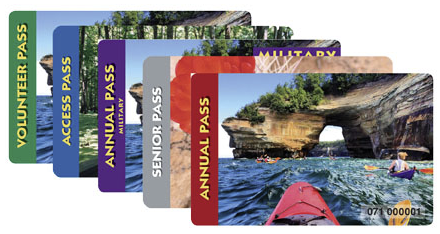
The America the Beautiful Annual Pass
The US National Park Pass is a good deal! For the most current information on passes, reference the National Park Service website. You can order passes online or get them at any of these Federal Recreation Areas.
Daypack for Outdoor Winter Activities at Yellowstone
- WATER – water bottles or hydration backpack
- Clothing layers (see more details below)
- Healthy snacks
- Flashlight or headlamp
- Sunscreen – yes, even in the winter!
- Lip protection with sunscreen
- Polarized sunglasses – to protect against the sun on the snow
- Hand lotion
- Hand sanitizer
Other Important Gear to Pack
- Cell phone
- Portable charger
- Medications
- Binoculars
- Camera Gear
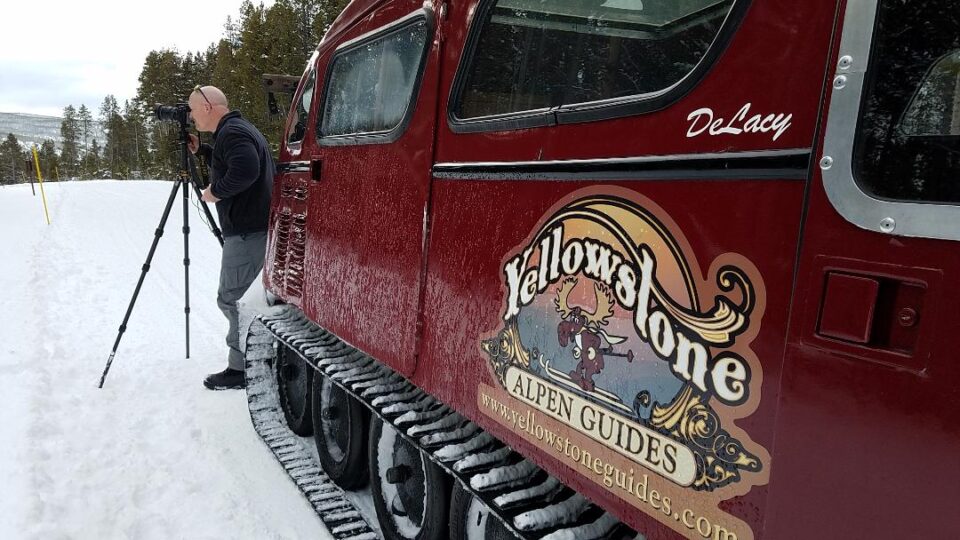
Winter Packing Checklist for Yellowstone
Here’s a winter clothing guide for outdoor travel and photography when visiting Yellowstone this time of year.
Insulated Winter Boots
We highly recommend insulated winter boots for Yellowstone in the winter. They should be rated for 20 below zero Fahrenheit or colder. Single layer insulated boots with the equivalent of 400 grams of Thinsulate insulation or the equivalent are recommended.
Be sure to size your boot by wearing a thicker sock or sock liner to make sure blood circulation isn’t compromised. Baffin insulated boots are the BEST boots for extreme cold!
Wool Socks
The important thing with socks is to make sure that there is plenty of space in your boots to wiggle your toes around as this increases blood circulation and foot warmth.
We like merino wool socks from Darn Tough – seriously the BEST SOCKS EVER! On EXTREMELY cold days I will need to also use toe warmers, but usually the Darn Tough socks do the trick to keep me warm!
Winter Hats
Select a winter hat based on the temperature and the outdoor activities you may do.
- A lightweight wool or synthetic hat is best for warmer days or if the hike will require high exertion.
- A warmer, heavier weight hat is best for later in the day or if temperatures are very low.
We both really like fleece BUFFS to use as a hat, headband or neck gaiter.
Insulated Winter Gloves
Mitts provide more warmth that gloves, but gloves allow individual finger movement. If it’s extremely cold, use an insulating glove inside a waterproof shell mitt to provide dexterity and warmth.
Soft-shell gloves are lighter weight and best used when body movement will heat up your hands and keep them warmer.
Fleece and leather gloves are not recommended for outdoor hiking or photography in the winter.
SPECIAL PHOTOGRAPHY GLOVES: When you operate a camera in cold weather, you quickly realize that fingers are very vulnerable to the cold, and it’s hard to control settings on a camera while wearing heavy gloves.
Special photographers’ gloves provide protection while being thin enough to allow you to operate your camera. Some have fingertip covers that can be opened briefly to allow you to open the battery-compartment door, change memory cards or make camera settings, then resealed to continue providing warmth. Dave finds it hard to operate the camera buttons when using the new touch screen gloves with the rubberized pads at the ends of the fingers.
Also keep hand warmers in the flap of the photographer’s gloves and rechargeable hand warmers in your coat pocket to provide extra warmth to hands when needed. Warmers in your coat pocket also helps keep batteries warm.
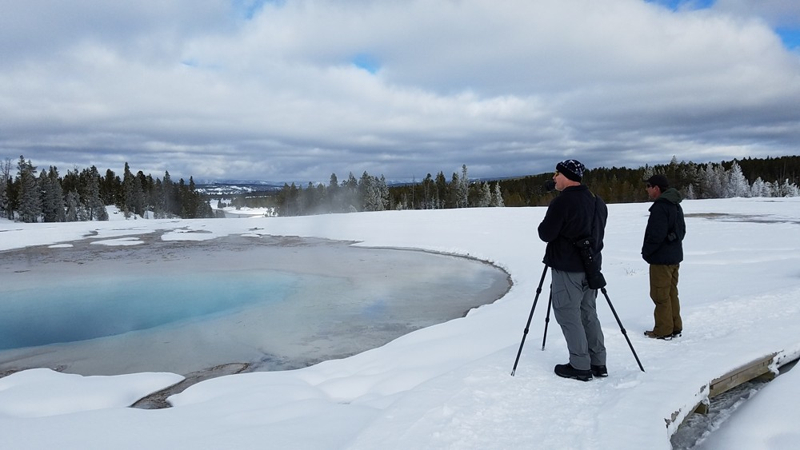
Winter Clothing Layers
Wearing layers during the winter is so important.
- Base layer (underwear layer): wicks sweat off your skin
- Middle layer (insulating layer): retains body heat to protect you from the cold
- Outer layer (shell layer): shields you from wind and rain
Even if you don’t wear all three layers at the outset, it’s a good idea to take all layers on every outing. You can peel off layers if things heat up, but you can’t put on layers that you didn’t bring along.
BASE LAYER
This base layer should be merino wool, synthetic or silk. The most important factor in choosing a base layer is that it should wick moisture away from your skin to the next highest layer of your clothing.
A base layer can be briefs, sports bras, long underwear tops and bottoms, tights and T-shirts. It’s up to you if you like it to fit snugly or loosely.
For very cold temperatures, thermal underwear is available in light-, mid- and expedition-weights. Choose the weight that best matches your activity and the temperature.
MID LAYER
The insulating mid layer helps you retain heat by trapping air close to your body. Fleece is usually the best insulating layer because it stays warm even if gets damp, and it dries fast.
Fleece also breathes well, so you’re less likely to overheat in it. The breathability of fleece is great, but the downside is the wind blows right through and takes away the warmth. That’s why you need to have a shell layer with you if you’re going with a fleece middle layer.
MID-LAYER TOPS: Fleece jackets, pullovers, or vests will keep you warm when it’s wet and wick moisture away from your skin and base layers. Add a soft-shell jacket or a down or synthetic fill vest for a bit more warmth (see below). We have found Columbia fleece jackets to be the best!
MID-LAYER BOTTOMS: Fleece pants are breathable and form-fitting. They are water and wind resistant but not waterproof or windproof. The main function of the soft shell layer is breathability. Add soft-shell pants for a bit more warmth (see below).
SHELL LAYER
The shell or outer layer is for weather protection from wind, rain or snow. Most allow at least some perspiration to escape; virtually all are treated with a durable water repellent (DWR) finish to make water bead up and roll off the fabric.
An outer shell is an important piece in bad weather, because if wind and water are allowed to penetrate to your inner layers, you begin to feel cold. Furthermore, without proper ventilation, perspiration can’t evaporate but instead condenses on the inside of your shell. Fit is another consideration.
Your shell layer should be roomy enough to fit easily over other layers and not restrict your movement.
WATERPROOF/BREATHABLE SHELL: The rain pant helps shield you from high winds and sustained rainfall, and traps the heat held by your mid-layer garments. Look for waterproof, breathable shell jackets with an integrated adjustable hood and at least two exterior pockets to stash hats and gloves. Find waterproof, breathable shell pants that have zips at the bottom of the leg so you can put them on or take them off without having to take off your boots.
WATER RESISTANT/BREATHABLE SHELL: The water resistant, breathable jackets and pants are best for light precipitation and high activity levels. They’re usually made of tightly woven fabrics (such as mini-ripstop nylon) to block wind and light rain.
SOFT SHELL: Soft shell jackets and pants emphasize breathability. Most feature stretch fabric or fabric panels for added comfort during aerobic activities. Many offer both shell and insulative properties, so they in effect combine 2 layers into 1. Soft shells include cold- and mild-weather options.
INSULATED SHELL: Insulated jackets and pants offer the best protection for extreme cold. Some outer shells have a layer of insulation built in—such as fleece—making them convenient for cold, wet conditions, but not as versatile for layering in fluctuating temperatures.
The insulated jackets at Columbia are amazing! The TurboDown and OmniHeat products really do keep you warm. And that’s saying something from someone who gets cold so fast. Columbia is my go-to jacket every time!
When you’re taking a break during a winter hike and have stopped moving, it’s best to pull a big puffy insulated jacket out of your backpack and wear it over your other clothes to stay warm.
DOWNLOAD the Yellowstone Packing Lists for winter and summer!
Plan a Yellowstone Winter Vacation
- Yellowstone National Park Travel Guide
- Yellowstone in December
- Yellowstone in January
- Yellowstone in February
- Yellowstone Winter Lodging
- Yellowstone National Park Winter Pictures
- Yellowstone National Park Winter Tours
